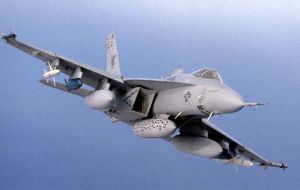MercoPress. South Atlantic News Agency
US Navy Celebrates Earth Day With Flight Test of “Green” F/A Super Hornet
 The multi-role fighter jet powered by a 50/50 blend of conventional jet fuel and camelina aviation bio-fuel
The multi-role fighter jet powered by a 50/50 blend of conventional jet fuel and camelina aviation bio-fuel The United States Navy celebrated Earth Day April 22 by showcasing a flight test of the “Green Hornet,” an F/A-18 Super Hornet multi-role fighter jet powered by a 50/50 blend of conventional jet fuel and camelina aviation bio-fuel.
The test, conducted at Naval Air Station Patuxent River, Maryland drew hundreds of onlookers, including Secretary of the Navy Ray Mabus, who has made the exploration and adoption of alternative fuels a priority for the Navy and Marine Corps.
Among the onlookers, Scott Johnson, general manager of Sustainable Oils which produced the camelina. “It was awesome to watch camelina biofuel break the sound barrier,” after watching the takeoff at the airbase and seeing the remainder of the flight via the Navy’s in-flight video feed.
The US Defence Energy Support Centre, which oversees procurement of biofuel for the Navy, recently awarded a 2.7 million USD contract to Sustainable Oils of Seattle and Bozeman, Mont., for 40,000 gallons of camelina-based fuel. The Navy’s ultimate goal is to develop protocols to certify alternative fuels for use in its aircraft and ships.
Sustainable Oils has partnered with Honeywell’s UOP to hydro-treat the oil and produce in-spec aviation fuel. UOP and Sustainable Oils were among those named 2009’s Biofuels Companies of the Year by Biofuels Digest for their achievements in aviation biofuels development.
“Our mission today and for the rest of the flight tests is to confirm that the fuel makes no difference in performance across the Super Hornet’s entire flight envelope, from subsonic to supersonic operations,” said Mark Swierczek, Naval Air Systems Command propulsion flight test engineer.
“Preliminary results show there was no difference in engine ops attributable to the bio-fuel. Engine performance is normal and as expected”.
Mabus observed the flight and tracked its data from a Project Engineering Station at the air station’s Atlantic Test Range. After the jet landed, he met the pilot, Lt. Cmdr. Tom Weaver, of Billerica, Mass.
“These flight tests are part of an extensive test and evaluation process that started last fall,” said Rick Kamin, the Navy’s Fuels team lead. “The fuel’s chemical and physical properties were first analyzed in the lab, followed by component and engine performance testing—and now in a series of flight tests covering the entire flight envelope of the Super Hornet—including supersonic operations.”
According to Kamin, final approval and certification for the camelina-based biofuel could take an additional six to nine months after flight test April 22. The Earth Day flight test is one of 15 planned test flights requiring approximately 23 flight-hours to complete, starting in mid-April 2010 and completing by mid-June 2010.
The Earth Day flight lasted about 45 minutes. Once successfully demonstrated on the F/A-18 F414 engine, the Navy will expand its certification efforts to other Navy and Marine Corps aircraft and Navy tactical systems.




Top Comments
Disclaimer & comment rulesCommenting for this story is now closed.
If you have a Facebook account, become a fan and comment on our Facebook Page!